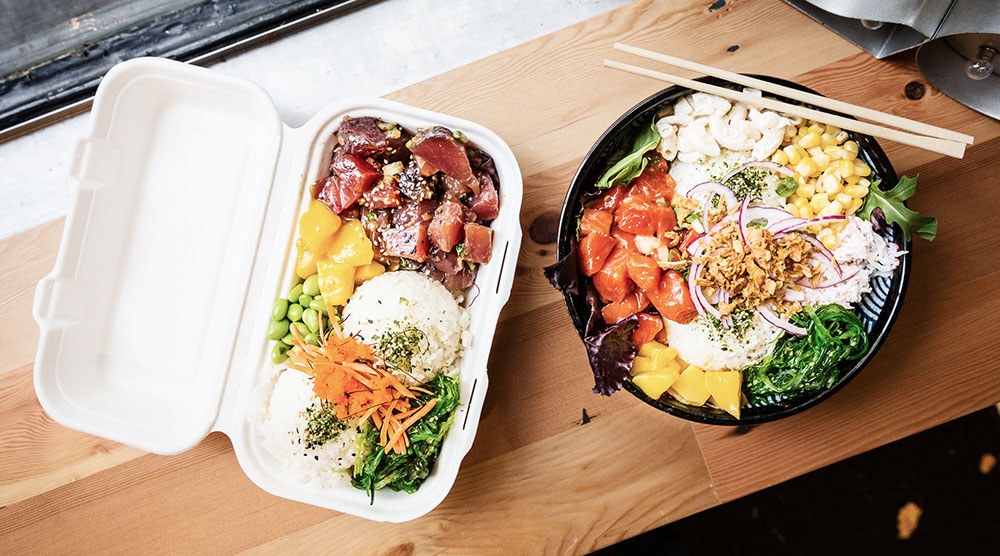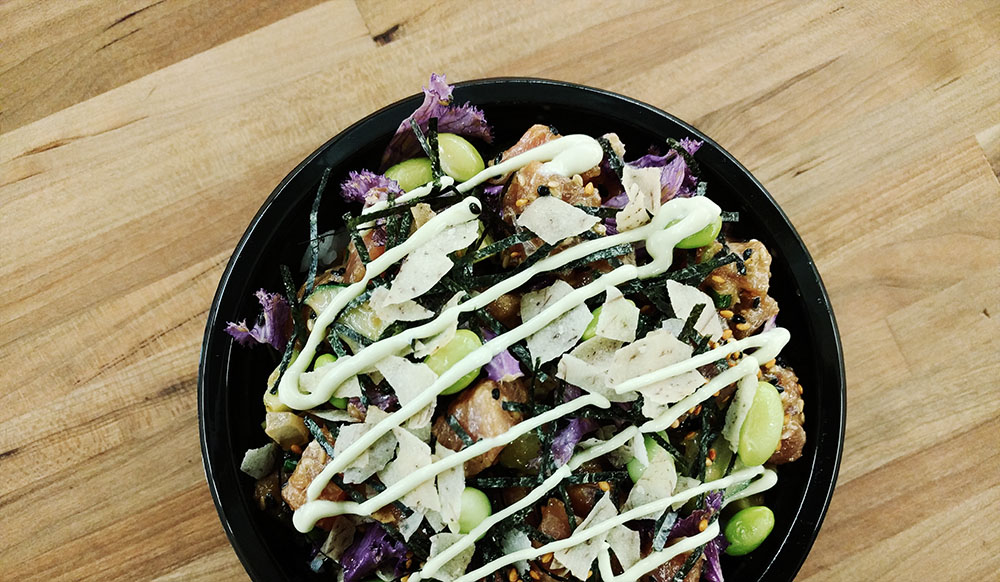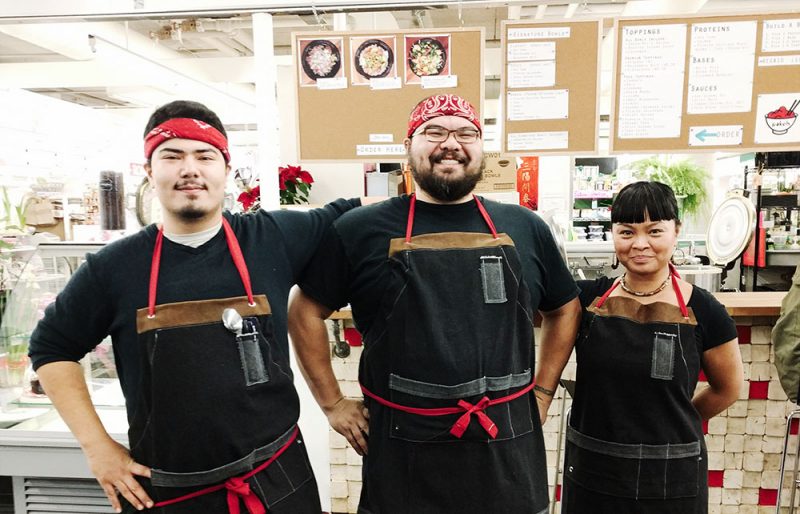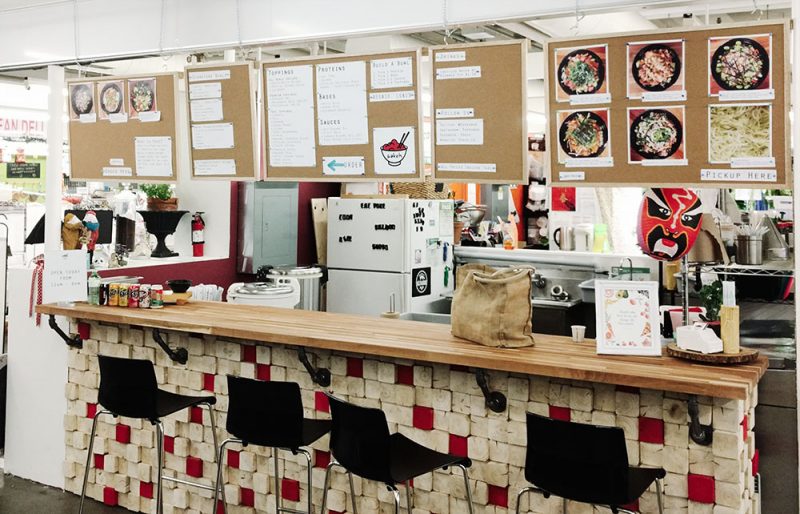Hawaii’s poke bowl does it all

The culinary trends of 2018 build on those things consumers want more and more: new experiences, variety of protein, sustainable ingredients and street-style convenience sourced from every corner of the world. One dish that checks of each and every one of those boxes is Hawaii’s poke bowl.
“So, first things first: poke is pronounced ‘po-kay’ — or even ‘po-kee’ would be acceptable,” explains Jak Wong, who owns The Poke Guy in Vancouver with his wife, Angela. They started the restaurant in 2016 as a way to enjoy the dish all year round, as opposed to only when visiting Angela’s relatives in Hawaii. “So ‘poke’ is actually a native Hawaiian verb — and it means to ‘cross cut’ or ‘dice.’ This means that you can technically ‘poke’ anything: chicken, beef, vegetables. The name has become synonymous with fish — and more specifically, ahi tuna —because that is the most abundant type of poke in Hawaii.”
While poke bowl is often labelled as “fish salad,” or a variation on sashimi, that’s not always the case. In fact, you can make them with any type of protein (or none, if you prefer). This versatility, combined with the great flavours, is part of the, if not the whole, reason poke bowls have captured the hearts and stomachs of Canadians over the past two years.
“Canadians are very health conscious. Not only is poke delicious, it has many health benefits, as fish is loaded with Omega 3,” says Cindy Nguyen. She and her husband, David, own Po-ke in Calgary, where she creates new recipes for the menu. “People are getting tired of eating chicken and salad overall when dieting.”
“There is a huge shift in lifestyle and diet, which I believe has had a major impact on how poke is being received in Canada,” mentions Wong. “People are becoming increasingly conscious of what they are consuming and they are actively selecting alternatives, which is where the poke bowl fits in.” The Poke Guy partners with Ocean Wise to ensure that its seafood is sourced sustainably and with respect to the environment.
Of course, the fact the poke bowl is delicious also helps quite a bit.
Salar Madadi, manager and chef at the Hamilton-based Pokeh, Canada’s first poke bowl restaurant, fell in love with poke on his honeymoon in 2012. “We tried it at a literal hole in the wall named Poke-Poke, and went back for a bunch after that,” Madadi recounts. “I think poke became popular because it’s a fantastic meal and people just had to try it. It’s fresh, healthy and uses very little in the way of processed ingredients. It’s adaptable for people with almost any kind of allergy or diet plan, and most importantly, it’s delicious.”
While it is now a main course for many, poke started out as a snack for fishermen — they’d season the raw fish and munch on it to tide them over until they got home. “The evolution of poke is something that is really fascinating to me,” Madadi explains. “It started using reef fish, seaweed, kukui nuts and salt. As immigration brought other cultures to Hawaii, and fishing practices changed, the types of seafood used changed, and the other cultures added their own influences, like adding shoyu. When it started to get picked up in California, there was another evolution, with more of a change to being freshly mixed as opposed to marinated, and more fresh vegetables being brought into play.”
- The staff at The Poke Guy in Vancouver
- The staff at Hamilton’s Pokeh: Shayne Madadi Salar Madadi and Karen Ancheta
- Pokeh’s original stall in Hamilton.
In fact, in Hawaii, the bowl format is still uncommon. “Poke is what Hawaiians call a ‘pu pu’ dish — finger foods or appetizers,” explains Wong. “The most common way that we’ve experienced poke in a Hawaiian household is usually as an appetizer that goes along with the other main courses — and there are usually A LOT of main courses.”
The bowl format is very popular in the U.S. and Canada. As Madadi mentions, it started in California, and spread from there. While the contents do change, one theme remains the same in every poke bowl: it always consists of at least three “layers”: the protein, the additions/ingredients and the sauce.
“The traditional poke bowl consists of five main ingredients … such as soy sauce, sea salt, green onions, Maui onions and limu, a seaweed,” explains Nguyen. “Modern and West Coast versions of poke can include avocado, ponzu sauce, teriyaki sauce, mushrooms, crispy onions, pickled jalapeno, Sriracha sauce, cilantro, pineapple or cucumber.”
Preparation of the bowl varies from place to place — another example of its versatility. “At The Poke Guy, we prepare ours the traditional Hawaiian way: the poke is marinated before the customer enjoys it. Our bowls have an incredible depth of flavours,” Wong states. “[It] is delicious by itself, but we also have a variety ingredients and sauces to fine-tune and complement the poke in your bowl.”
While Wong focusses on authentic Hawaiian prep, Madadi prefers to add another level of evolution to his bowls. “What we do at Pokeh is a natural evolution from there, bringing in another layer of influences to make our version,” he says. “We like to provide contrasts in our poke bowls — with differences between textures and tastes and temperatures. Cool fish on hot rice is one, and the many types of textures we incorporate — from the fish, to the fresh vegetables, to the crunchy toppings, to the creamy sauces. All of the layers and contrast make each bite delicious and different.”
At Po-ke, Nguyen and her husband focus on the sauce, and use that to influence the layers. “We make our own savoury signature sauce that’s a miso base, and it’s loaded with flavour … No one but David and I knows this sauce recipe,” Nguyen says. “All of the layers play off one another, giving various textures and tastes in each bite. We recommend the right proportion of fish and rice to in every bite along with other ingredients.”
At the forefront of every poke bowl is the ingredients, and the mantra “fresh is best” holds true here. “To make poke the way they do in Hawaii,” Wong explains, “you need fresh fish — the fresher the better — sweet onions, green onions, shoyu-flavoured poke sauce, a little bit of Hawaiian salt — sea salt can be used as a substitute — sesame oil, ogo seaweed — if you want that ‘oceany’ taste — macadamia nuts and sesame seeds. From here, you can enjoy it with some warm rice and add veggies and toppings as you please. My personal favourite flavour of poke is our Hula-peno ahi. I usually pair that up with brown rice, edamame, wasabi-slaw — something that we whip up at the shop — sweet corn, imitation crab, cilantro, green onion, crispy onions, masago, nori and top off the salad with a little bit of roasted sesame dressing.”
“Fresh fish is the essential component of a great poke dish,” Nguyen adds. “You always want to ensure that you’re using only high-quality sushi grade fish when making poke, as it’s raw fish and you don’t want to run the risk of getting sick.”
The seasoning and sauce should be added with restraint, so it adds flavour without drowning or overpowering the poke bowl. “Taste your poke as you’re making it and adjust the seasoning as you go,” Madadi advises. “My favourite poke is our spicy bowl with jicama and green mango added. I love the heat from the spicy kewpie mayo, spicy sesame seeds and pickled jalapeños, the crunch from the jicama and the slight tartness from the green mango.”
If you plan on experimenting with your own poke bowl at home, remember these tips from the experts. The first, is, of course, finding fresh ingredients. The second is to marinate your protein. “If making the traditional shoyu sauce, let the fish marinate for 24 hours before serving,” Nguyen explains, “this will allow the sauce to soak into the fish.” Go easy on the sauce, serve with warm rice, make enough to share and, my favourite, experiment!
To me, in the end, the poke bowl is about finding that depth and those layers of flavours that will give you a unique experience with each bite — and remind you just how wonderful nature’s produce can be. So, head to your farmers’ market, find yourself some fish and try out these recipes from the poke experts!

Poke bowl served up at Pokeh in Hamilton
Traditional Shoyu Poke
by Jak Wong, The Poke Guy
Serves 4
We always recommend using wild and sustainably caught seafood.
1 lb fresh fish (or seafood)
1/4 cup shoyu (soy sauce or tamari)
1/4 cup sweet onion, chopped
2 tbsp green onion, chopped
1 tsp fresh ginger, grated
2 tsp Alaea salt (Hawaiian sea salt)
1 tsp sesame oil
Sesame seeds or furikake (Japanese rice seasoning)
Cut fish into 1/2-inch cubes, set aside.
Make the marinade by combining the shoyu, onions, ginger, salt and sesame oil in a bowl. Add the cubed fish to the marinade and mix well so that all the fish is covered. Refrigerate and marinate for a minimum of 15 minutes.
Season with some sesame seeds or furikake.
Serve with rice or salad.
Pokeh’s Classic Poke
by Salar Madadi, Pokeh
Serves 2
We use Calrose rice and Yamasa soy sauce.
1 cup uncooked short-grain or sushi rice
4 tsp soy sauce
2 tsp sesame oil
1/2 lb raw ahi tuna, cut into bite-sized cubes
1/3 cup cucumbers, diced
2 tbsp white onion, finely diced
1 tbsp green onion, finely sliced
2 tbsp macadamia nuts, roughly chopped
1 1/2 tsp black and white sesame seeds
In a small saucepan over medium heat, combine rice and 2 cups water. Stir, cover and bring to a gentle boil. Turn heat down to low and continue to cook covered on a gentle simmer for 20 minutes, or until the rice is tender and most of water is absorbed. Remove from heat, fluff with a fork and set aside.
In a mixing bowl, whisk together the soy sauce and sesame oil. Toss in the tuna, cucumber, and onions, ensuring everything is evenly coated.
Transfer the rice to a serving bowl. Top with the marinated tuna mixture. Garnish with macadamia nuts and sesame seeds just before serving.



